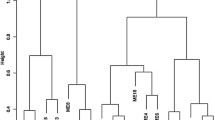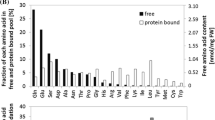Abstract
Amino acid metabolism is among the most important and best recognized networks within biological systems. In plants, amino acids serve multiple functions associated with growth. Besides their function in protein synthesis, the amino acids are also catabolized into energy-associated metabolites as well we into numerous secondary metabolites, which are essential for plant growth and response to various stresses. Despite the central importance of amino acids in plants growth, elucidation of the regulation of amino acid metabolism within the context of the entire system, particularly transcriptional regulation, is still in its infancy. The different amino acids are synthesized by a number of distinct metabolic networks, which are expected to possess regulatory cross interactions between them for proper coordination of their interactive functions, such as incorporation into proteins. Yet, individual amino acid metabolic networks are also expected to differentially cross interact with various genome-wide gene expression programs and metabolic networks, in respect to their functions as precursors for various metabolites with distinct functions. In the present review, we discuss our recent genomics, metabolic and bioinformatics studies, which were aimed at addressing these questions, focusing mainly on the Asp-family metabolic network as the main example and also comparing it to the aromatic amino acids metabolic network as a second example (Angelovici et al. in Plant Physiol 151:2058–2072, 2009; Less and Galili in BMC Syst Biol 3:14, 2009; Tzin et al. in Plant J 60:156–167, 2009). Our focus on these two networks is because of the followings: (i) both networks are central to plant metabolism and growth and are also precursors for a wide range of primary and secondary metabolites that are indispensable to plant growth; (ii) the amino acids produced by these two networks are also essential to the nutrition and health of human and farm animals; and (iii) both networks contain branched pathways requiring extensive regulation of fluxes between the different branches. Additional views on the biochemistry, regulation and functional significance of the Asp-family and aromatic amino acid networks and some of their associated metabolites that are discussed in the present report, as well as the nutritional importance of Lys and Trp to human and farm animals, and attempts to improve Lys level in crop plants, can be obtained from the following reviews as examples (Radwanski and Last in Plant Cell 7:921–934, 1995; Halkier and Gershenzon in Annu Rev Plant Biol 57:303–333, 2006; Ufaz and Galili in Plant Physiol 147:954–961, 2008; Jander and Joshi in Mol Plant 3:54–65, 2010).


Similar content being viewed by others
References
Angelovici R, Fait A, Zhu X, Szymanski J, Feldmesser E, Fernie AR, Galili G (2009) Deciphering transcriptional and metabolic networks associated with lysine metabolism during Arabidopsis seed development. Plant Physiol 151:2058–2072
Arruda P, Kemper EL, Papes F, Leite A (2000) Regulation of lysine catabolism in higher plants. Trends Plant Sci 5:324–330
Dubouzet JG, Ishihara A, Matsuda F, Miyagawa H, Iwata H, Wakasa K (2007) Integrated metabolomic and transcriptomic analyses of high-tryptophan rice expressing a mutant anthranilate synthase alpha subunit. J Exp Bot 58:3309–3321
Goto DB, Ogi M, Kijima F, Kumagai T, van Werven F, Onouchi H, Naito S (2002) A single-nucleotide mutation in a gene encoding S-adenosylmethionine synthetase is associated with methionine over-accumulation phenotype in Arabidopsis thaliana. Genes Genet Syst 77:89–95
Halkier BA, Gershenzon J (2006) Biology and biochemistry of glucosinolates. Annu Rev Plant Biol 57:303–333
Herrmann KM (1995) The Shikimate pathway: early steps in the biosynthesis of aromatic compounds. Plant Cell 7:907–919
Jander G, Joshi V (2010) Recent progress in deciphering the biosynthesis of aspartate-derived amino acids in plants. Mol Plant 3:54–65
Joshi V, Jander G (2009) Arabidopsis methionine gamma-lyase is regulated according to isoleucine biosynthesis needs but plays a subordinate role to threonine deaminase. Plant Physiol 151:367–378
Joshi V, Laubengayer KM, Schauer N, Fernie AR, Jander G (2006) Two Arabidopsis threonine aldolases are nonredundant and compete with threonine deaminase for a common substrate pool. Plant Cell 18:3564–3575
Kroymann J, Textor S, Tokuhisa JG, Falk KL, Bartram S, Gershenzon J, Mitchell-Olds T (2001) A gene controlling variation in Arabidopsis glucosinolate composition is part of the methionine chain elongation pathway. Plant Physiol 127:1077–1088
Less H, Galili G (2009) Coordinations between gene modules control the operation of plant amino acid metabolic networks. BMC Syst Biol 3:14
Malitsky S, Blum E, Less H, Venger I, Elbaz M, Morin S, Eshed Y, Aharoni A (2008) The transcript and metabolite networks affected by the two clades of Arabidopsis glucosinolate biosynthesis regulators. Plant Physiol 148:2021–2049
Mène-Saffrané L, Dellapenna D (2009) Biosynthesis, regulation and functions of tocochromanols in plants. Plant Physiol Biochem. doi:10.1016/j.plaphy.2009.11.004
Radwanski ER, Last RL (1995) Tryptophan biosynthesis and metabolism: biochemical and molecular genetics. Plant Cell 7:921–934
Rebeille F, Jabrin S, Bligny R, Loizeau K, Gambonnet B, Van Wilder V, Douce R, Ravanel S (2006) Methionine catabolism in Arabidopsis cells is initiated by a gamma-cleavage process and leads to S-methylcysteine and isoleucine syntheses. Proc Natl Acad Sci USA 103:15687–15692
Schuster J, Knill T, Reichelt M, Gershenzon J, Binder S (2006) Branched-chain aminotransferase4 is part of the chain elongation pathway in the biosynthesis of methionine-derived glucosinolates in Arabidopsis. Plant Cell 18:2664–2679
Shen B, Li CJ, Tarczynski MC (2002) High free-methionine and decreased lignin content result from a mutation in the Arabidopsis S-adenosyl-L-methionine synthetase 3 gene. Plant J 29:371–380
Textor S, de Kraker JW, Hause B, Gershenzon J, Tokuhisa JG (2007) MAM3 catalyzes the formation of all aliphatic glucosinolate chain lengths in arabidopsis. Plant Physiol 144:60–71
Tzin V, Malitsky S, Aharoni A, Galili G (2009) Expression of a bacterial bi-functional chorismate mutase/prephenate dehydratase modulates primary and secondary metabolism associated with aromatic amino acids in Arabidopsis. Plant J 60:156–167
Ufaz S, Galili G (2008) Improving the content of essential amino acids in crop plants: goals and opportunities. Plant Physiol 147:954–961
Urano K, Maruyama K, Ogata Y, Morishita Y, Takeda M, Sakurai N, Suzuki H, Saito K, Shibata D, Kobayashi M, Yamaguchi-Shinozaki K, Shinozaki K (2009) Characterization of the ABA-regulated global responses to dehydration in Arabidopsis by metabolomics. Plant J 57:1065–1078
Vogt T (2009) Phenylpropanoid biosynthesis. Mol Plant 3:2–20
Yatusevich R, Mugford SG, Matthewman C, Gigolashvili T, Frerigmann H, Delaney S, Koprivova A, Flugge UI, Kopriva S (2009) Genes of primary sulfate assimilation are part of the glucosinolate biosynthetic network in Arabidopsis thaliana. Plant J (in press)
Author information
Authors and Affiliations
Corresponding author
Rights and permissions
About this article
Cite this article
Less, H., Angelovici, R., Tzin, V. et al. Principal transcriptional regulation and genome-wide system interactions of the Asp-family and aromatic amino acid networks of amino acid metabolism in plants. Amino Acids 39, 1023–1028 (2010). https://doi.org/10.1007/s00726-010-0566-7
Received:
Accepted:
Published:
Issue Date:
DOI: https://doi.org/10.1007/s00726-010-0566-7




